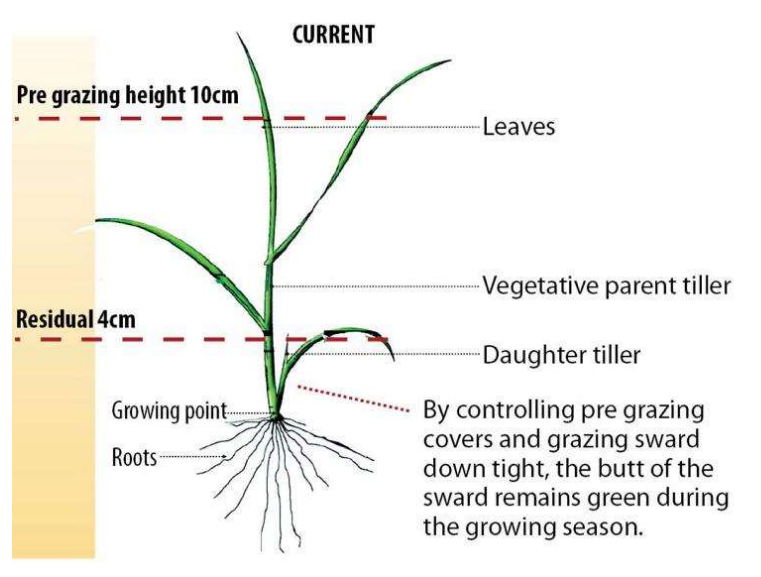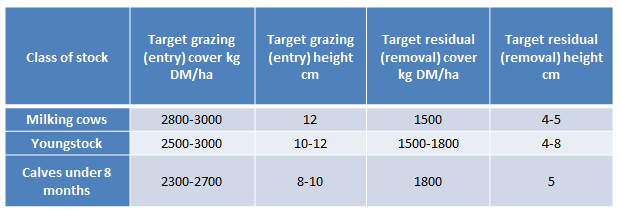Getting Started with Rotational Grazing for the Dairy Herd
Rotational grazing involves using small fields sizes, (or paddocks) to move stock frequently to provide a rest for the grass and reduce wastage. Rotational grazing increases the utilisation of grass grown, which allows you to increase stocking density in comparison to a set stocked system – a benefit if grazing land is in short supply or you want to expand the herd. By grazing more intensively and allowing the grass to rest, grass utilisation increases resulting in better pasture quality and a greater grass yield. It can also extend the grazing season.
Set Up
Below is an example of a simple three-week, three-day rotation which involves:
- Eight paddocks
- Moving cows every three days
- Providing a three-week rest period for each paddock
You have control over the intensity and duration of grazing in a paddock, the length of the rest period and the size and number of paddocks. However, four days is the maximum length cows should be in a paddock for as during this time they can graze regrowth, compromising the speed at which that plant grows.
Utilisation tends to increase with a shorter grazing duration per paddock as grazing pressure is intensified and there is less opportunity to waste grass.
Rest Period
The length of rest period will depend on the time of year and the grass growing conditions (i.e. how long it takes for the grass plant to regrow to the target pre-grazing height). A guide to the length of the rotation is as follows:
- Spring: 15-21days
- Summer: 25-30 days
- Autumn: 30-40 days
- Winter: 90-100 days
The rest period must be adjusted according to grass growth. If growth slows more paddocks will be required in the rotation to increase the rest period in order to achieve the target pre-grazing cover.
Grass Covers (height) – The 3-Leaf Rule
The aim is for cows to enter paddocks when the grass plant is at the 3-leaf stage. Once the 4th leaf emerges, the first leaf dies off. If grass is left to grow beyond the 4-leaf stage there will be a build-up of dead material at the base of the plant, reducing its nutritional value and shading out regrowth which will impact on future yield. Similarly, grazing below the target residual places stress on the grass plant to use energy from root reserves and slows growth and plant persistency.
A perennial ryegrass plant with target pre-grazing and post-grazing heights
Target grass covers and grass height
Visual guide to grass covers
Managing your swards based on pre- and post-grazing target covers requires close observation of your pastures and weekly measurements of grass growth should be made, either with a plate meter, sward stick or visual assessment. Software is a useful management tool to help create and manage grass budgets on your farm and there are many programmes available to aid decision making.
An easy way to do this is to use markers on your wellies to give you a guide to grass covers.
Maximising pasture growth and utilisation relies on managing the post-grazing residual. Remove cows from paddocks when they have grazed down to 4 to 5cm or a 1500kg DM/ha residual. The aim is to graze to the same residual each time. This can be challenging in very wet weather but avoiding poaching should be the priority at the expense of a higher residual. Once the weather improves and conditions allow, refocus back on the target residual.
Calculating Demand
Know how much dry matter intake from grass you are aiming to achieve. For example, if you are targeting an intake of 15kg of dry matter from grass:
- Pre-grazing cover target = 2,800kg DM/ha
- Post-grazing cover target = 1,500kg DM/ha
- Available grazing cover is the difference = 2,800 – 1,500 = 1,300kg DM/ha
Targeting a 15kg dry matter intake means that 1,300kg will support 86 cows in a 1-hectare paddock per day.
Early Season Entry
For the first grazing round, lower turnout covers should be used, otherwise the ungrazed paddocks will be over mature and of poorer nutritional value. Consider turning out at covers of 2200kg DM/ha for the first few paddocks and then increase to 2800kg DM/ha in order to establish a wedge. The aim is to have paddocks at different stages of grass growth and manage movement of stock accordingly so that they are going into grass covers of the same height throughout the season.
Reacting to Grass Growing Conditions
It is likely when grass growth is at its peak, the grass will get ahead of you and will be above the target entry cover when moving in stock. In this situation consider taking out a paddock or two for conservation which will reduce the rotation length.
If grass growth is getting ahead and outstrips demand:
- Take paddocks out of rotation for conservation
- Move stock out of paddock earlier and graze with another group of stock with a lower feed demand to achieve the target residual (heifers or dry cows)
- Mowing or topping
If grass growth is slowing and below demand:
- Bring in additional paddocks by using fields designated for silage
- Apply nitrogen
- Provide buffer feed to reduce the amount of grass required
- Reduce stocking density
Animal performance should not be compromised so it is important to match their demand to the grass available to graze and remember the 3-leaf rule!
This information is available to download using the link below.
Sign up to the FAS newsletter
Receive updates on news, events and publications from Scotland’s Farm Advisory Service




